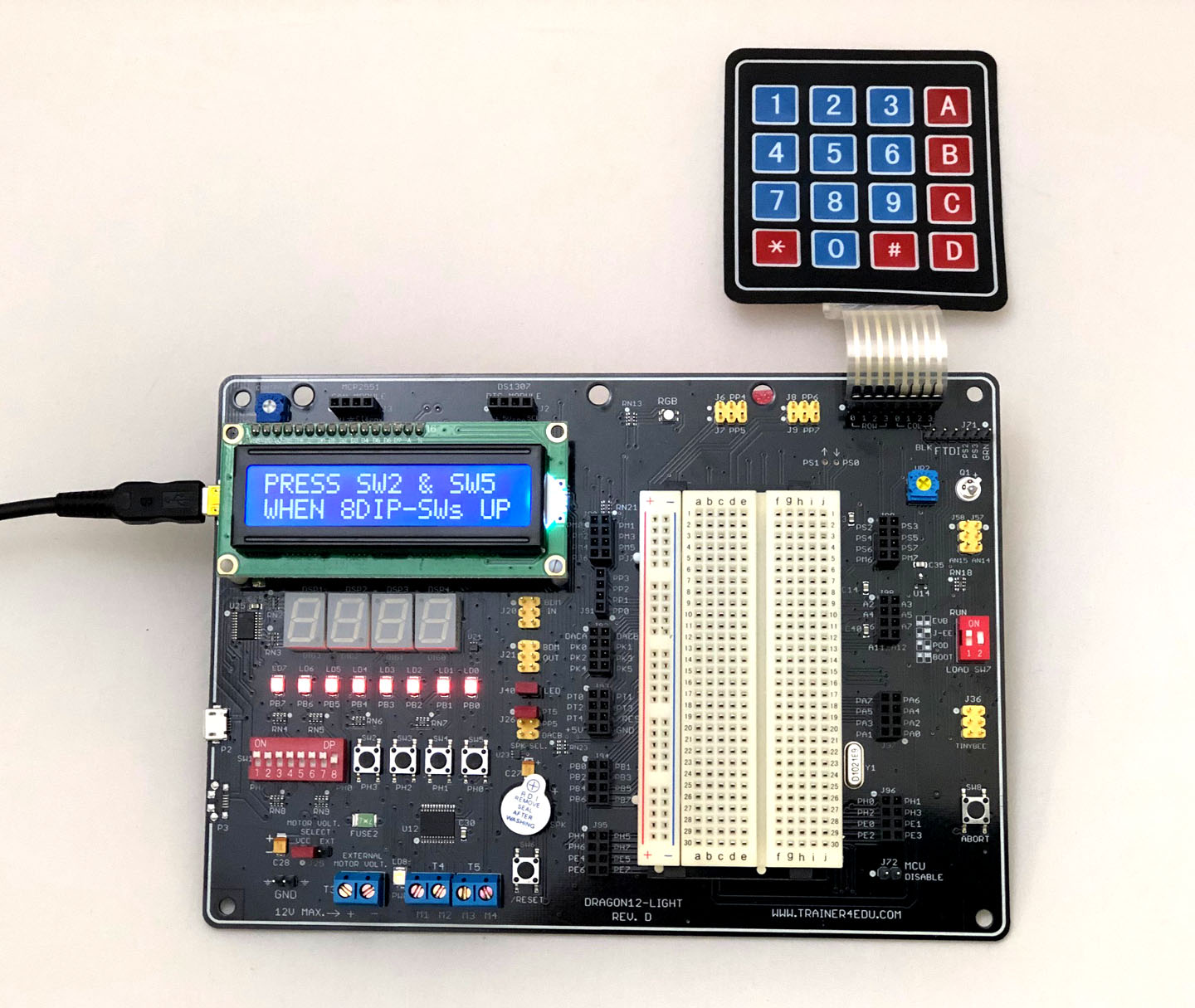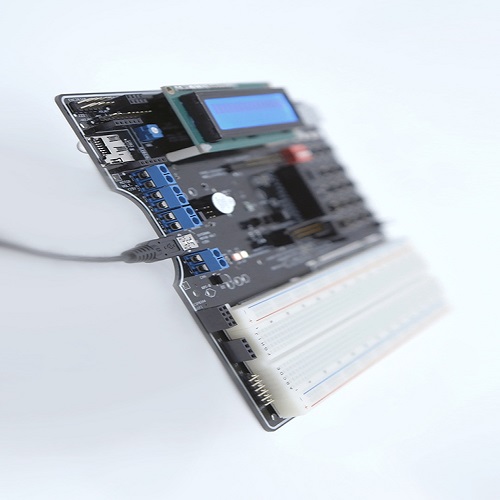| |

DRAGON12-Light Trainer
Rev. D
A popular upgrade for 68HC11 and 68HC12
boards
A popular upgrade for 68HC11 and 68HC12 boards.
The DRAGON12-Light
trainer Rev. D comes
with D-Bug12 monitor firmware or serial monitor
firmware installed.
The D-Bug12 monitor for
HCS12 is similar to the BUFFALO monitor for 68HC11. It will execute
all BUFFALO
commands and work with an ASCII
terminal program, like AsmiDE and MiniIDE. With the vast online
resources available for the HCS12, it will not take much time to start a HCS12 course for a professor who is currently
teaching a 68HC11 or a 68HC12 course.
The serial monitor is required to work with the
CodeWarrior IDE 5.1 SE. That's only version will
support the serial monitor.
DRAGON12-Light
Rev D.
silkscreen
Sample programs and Textbooks
The DRAGON12-Light Rev. D
trainer kit includes a DRAGON12-Light board, a solderless breadboard
and a
3 foot USB cable.
DRAGON12-Light features:
-
Backwards compatible to 68HC11
and 68HC12 code
-
Supports source level
debugging with single step and breakpoints for C and Assembler
-
On-board CH340G USB interface
with auto installation for Windows 10
-
RGB color LED
-
16X2 LCD display module with LED backlight.
-
4-digit, 7-segment display module for learning multiplexing
technique
-
4 X 4 membrane keypad
-
Eight LEDs connected to port B
-
An 8-position DIP switch connected to port H
-
Four pushbutton switches
connected to PH0-PH3
-
Speaker driven by timer, or PWM, or DAC for alarm,
voice and music applications
-
Light sensor for home automation
applications
-
Potentiometer for analog input
-
Temperature sensor for home
automation applications
-
X-Y-Z accelerometer module interface header
-
Two analog sensor input headers
-
Dual
10-bit DAC for generating analog waveforms
-
High efficiency dual H-Bridge for controlling two DC motors or one stepper motor
-
Four robot servo PWM outputs
-
Resettable fuses to protect USB port
and H-bridge controller
-
Abort switch for stopping program
in D-Bug12 when program is hung in a dead loop
-
BDM-in connector to be connected with a BDM from
multiple vendors for debugging.
-
BDM-out connector
for making this board as a HCS12 / 9S12 BDM or programmer. No extra hardware
needed.
-
4x2 Female headers provide shortest distance (great for high speed
applications!) to the most I/O pin of the MC9S12DG256
-
Bus speed up to 25 MHz
-
Comes with AsmIDE under GPL (general public license)
-
Pre-loaded with D-Bug12 monitor for working
with AsmIDE or serial monitor for
working with CodeWarrior
-
Mode
switch for selecting 4 operating modes with D-Bug12 monitor: EVB, Jump-to-EEPROM, BDM POD
and Bootloader
-
Fast prototyping with on-board solderless breadboard
-
Many fully debugged 68HC12 program examples
including source code
-
PCB size: 7.2" X 5.1"
Optional
plug-in modules for projects:
Applications:
- A perfect stand-alone 16-bit HCS12 trainer for
classrooms. It's not too simple like an 8-bit trainer and not too complex
like a
32-bit trainer
- Perfect for upgrading all outdated 68HC11 /
68HC12
development boards
MSRP: $189, Educational price: $169
Verify the type of monitor firmware on your Dragon12-Light board:
-
Apply power to your Dragon12-Light Rev D
board via a USB cable connecting to a USB port.
-
Observe the 8 port B LED indicators. (Make
sure that a jumper is placed on the J40 or the LEDs will not flash)
-
If your board is pre-installed
with D-Bug12 monitor firmware, the 8 port B LED indicators will flash
sequentially from
left to right and the speaker will chirp once when the
board is powered up. If the chirp is too soft you can remove the label sticker
on the speaker to increase volume.
-
If
you ordered the board with serial monitor firmware for the CodeWarrior, it would be
pre-installed with the serial monitor and a factory test program. The state of the left switch of the 2-position DIP switch (SW7) is
tested by the serial monitor for selecting RUN or LOAD mode during power up or
reset, and the 8 port B LED indicators will flash sequentially from right to left and the speaker will chirp once to indicate that the serial monitor
firmware
is functioning.
For more information please see this video:
http://www.youtube.com/watch?v=gmwBMWII0p8&feature=related
The video was made for the Dragon12_Plus2 board, but the procedure
is the same for the Dragon12_Light board.
If the left switch is placed in the "LOAD"
mode (in the "low" position) the monitor will wait for a command from
the host PC.
If the left switch is placed in
the "RUN" mode (in the "up" position) the 8 port B LED indicators will
flash again from left to right to indicate that the program execution is diverted
to the user code.
The
CodeWarrior communicates with Freescale serial
monitor firmware only in LOAD mode and so in order to interface with the CodeWarrior you have to
place the left switch
in the “low “ position. The 8 port B
LED indicators will flash from right to left and
the speaker will chirp once
when the board is
powered up.
If
your board does not communicate with CodeWarrior, the first thing
you should check is that if the left DIP switch of the SW7 is in the
LOAD mode ( in the "low" position).
-
If monitor firmware is not
installed or is erased
by a BDM,
the 8 port B LED indicators will not flash sequentially during power up or reset.
The
DRAGON12-Light Rev. D board comes with a
built-in USB interface based on the CH340G. The driver for the CH340G will be
automatically installed by Win10.
Install and verify USB driver:
-
Plug the Dragon12-Light Rev. D board to your PC
via a supplied USB cable. Let Win10 search the
driver on the web and automatically install it for you.
If the auto installation does not work for your PC
(it's very unlikely), you can download the exe file
and then run it to install the driver manually
http://www.wch.cn/downloads/CH341SER_EXE.html
The driver web site
is in Chinese, Google will ask if you want to
translate the page, click the Translate button, then
click the Download button. It will save the
CH341SER.exe in your HD. Just click it to run, it
will install the latest driver for you.
-
Verify it in Device Manager
-
Once you have verified that the USB
driver is properly installed, you may
invoke the IDE (CodeWarrior or AsmIDE, or MiniIDE).
-
If you
are going to use CodeWarrior IDE and have not installed it you need to
Download and configure CodeWarrior http://www.trainer4edu.com/dragon12/codewarrior_hcs12.html
For AsmIDE users:
If the
AsmIDE does not communicate with your Dragon12-Light board then you need to check if
the COM port number that is assigned by the AsmIDE matches the
USB-to-Serial COM port number that is
assigned by Windows' Device Manager. The Device Manager assigns the
USB-to-Serial COM port number randomly and it does not know which COM port
number that AsmIDE is going to use.
In order to find the USB-to-Serial COM port number
that is assigned by Device Manager, you can click through
"Control Panel -> Systems -> Hardware -> Device Manager -> Ports".
The
USB-to-Serial COM port number will appear.
For setting the COM port of the AsmIDE to match that USB-to-Serial COM port
number, you can click through "View-> Option->Terminal Window Options" menu,
then select the correct COM port from COM1 to COM4.
In order to establish a reliable USB
communication, always connect the DRAGON12-Light Rev. D board to your PC's USB port first
before invoking the AsmIDE, otherwise the AsmIDE will not be able to
communicate with the DRAGON12-Light Rev. D board. During a debugging session, if you
accidentally unplug the USB cable from the DRAGON12-Light Rev. D board, you need to re-establish the
USB communication. The AsmIDE will not recognize the DRAGON12-Light Rev. D board again
if you just simply plug the USB cable back.
To
re-establish the USB communication you
need to exit AsmIDE and power cycle the
DRAGON12_Lighy board (disconnect the USB cable from the DRAGON12-Light
Rev. D board, then re-plug in the USB cable),
then you can invoke AsmIDE again and the AsmIDE will start to communicate with the
DRAGON12-Light
Rev. D
board. If this does not work, you
may need to restart
your PC.
If
restarting the PC does not solve the problem, you can try it on another PC.
Download the MC9S12DG256 Device User Guide
http://pdf.datasheetcatalog.com/datasheet/motorola/9S12DT256DGV3.pdf
Download the D-Bug12 Reference
Guide, DB12RG4.pdf
http://www.ece.utep.edu/courses/web3376/Interrupts_files/DB12RG4.pdf
Download the AN2548.pdf
(serial monitor)
http://www.freescale.com/files/microcontrollers/doc/app_note/AN2548.pdf
Download the AN2153.pdf
(serial bootloader)
http://www.freescale.com/files/microcontrollers/doc/app_note/AN2153.pdf
|
|
 Trainer4Edu.com
Trainer4Edu.com